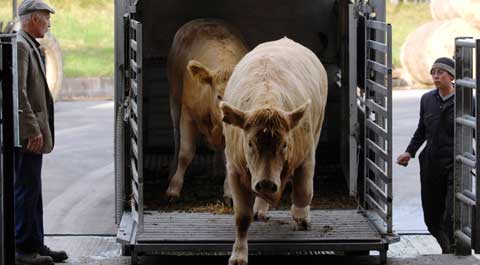Animal transport exam proves worthwhile

To many farmers, a certificate of competence to transport livestock is just another needless piece of bureaucracy. But as it is now an EU requirement for all journeys over 40 miles, there is no avoiding it.
With college but a distant memory, I had hoped the need to sit exams and tests was behind me. However, being offered the chance by Mid Kent Training and Field House Assessments to trial the NPTC and City and Guilds’ test for a Certificate of Competence in the Transport of Animals by Road, it was one test I didn’t feel I could miss.
After reading through the assessment notes, I was just a little daunted by the prospect. Having hauled livestock all over the UK for the past 10 years I was confident I knew the basics but, as always, the devil is in the detail.
For instance, just what is the minimum space allowance for a heavily pregnant sheep or a medium-sized calf? To be frank, I hadn’t a clue and nor I suspected, until reading these notes, would many others.
So arriving at Ashford Market to sit the test I was somewhat nervous. I’d spent the morning running through the notes in the hope some knowledge would sink in but, with little idea of what the test would entail, there was an innate fear of failure coursing through my veins.
Having been briefed on what the test would involve – 27 multiple choice questions with a pass mark of 21 – I settled down in front of the computer wondering what the first question would be. Would I flounder on a simple query such as: “Which factors will affect an animal’s ability to cope with stress?”, or would I be flummoxed by the more complex, such as calculating a journey time given a series of road speeds and distances?
Thankfully, the first question was tackled simply enough. After all, knowing who was responsible for the animals during transport wasn’t going to tax many. Particularly when the options available included the State Vet Service, the police and the Highways Agency – picking out the driver/attendant as responsible was an easy break-in.
And while a computer-based test might be a cause of anxiety among some older haulage drivers, with the mouse the only piece of equipment needed to complete the test, there was a feeling among my fellow guinea pigs that even more antique drivers would be able to finish within the allotted time of 60 minutes.
Answering the 27 questions on the sheep and cattle test was relatively straightforward, holding no fear for anyone with a modicum of common sense. Some of the questions required a little thought, but once two or three were under my belt the format was familiar.
And with two of the four answers given for each question reasonably ridiculous, applying the Who Wants To Be A Millionaire 50:50 strategy soon meant that picking the right answer from the two remaining became second nature.
So just 20 minutes later I found myself tackling question 27 out of 27 and wondering, as I had finished well ahead of time, whether I’d missed a couple in the middle. A quick review of the test revealed I had indeed answered all the questions and I was fairly confident I’d given it my best shot.
A short time later and my fate was known. Along with everyone else sitting the test that day, I had passed the test. More than that, I’d managed a full house of correct answers, something I can’t remember achieving since a spelling exam aged nine.
Overall then, this is one test I am more than happy to recommend. The qualification provides a high level of reassurance to the rest of the food chain that those of us involved in livestock production and transport are operating with animal health and welfare at the top of our agenda.
Here are three sample questions:
1. You are undertaking a journey which is 140 miles long. You average 50mph on motorways, 30mph on A roads and 20mph on B roads. The journey comprises 100 miles on motorways, 30 miles on A roads and 10 miles on B roads. How long does the journey take?
a. Three hours
b. Three and a half hours
c. Four hours
d. Four and a half hours
2. You are on a journey and on a routine inspection find an ill animal in the load. You are three hours from the point of departure and two hours from your destination. Who do you call for assistance?
a. The local vet
b. The police
c. The Highways Agency
d. The State Vet Service
3. What colour should the inside of a healthy animal’s mouth should be?
a. Blue
b. Bright red
c. Yellow
d. Pink
Make sure you are legal with your car and trailer
Ready to take your driving test?
Transport of animals by road. NPTC page with links to relevant documents. Call NPTC on 0247 685 7300 for more information.

